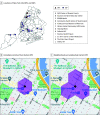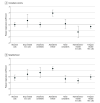Overdose Prevention Centers, Crime, and Disorder in New York City
- PMID: 37955901
- PMCID: PMC10644216
- DOI: 10.1001/jamanetworkopen.2023.42228
Overdose Prevention Centers, Crime, and Disorder in New York City
Abstract
Importance: The first government-sanctioned overdose prevention centers (OPCs) in the US opened in New York City (NYC) in November 2021 amid concerns that they may increase crime and disorder, representing a significant political challenge to OPCs.
Objective: To identify whether opening the first 2 government-sanctioned OPCs in the US was associated with changes in crime and disorder.
Design, setting, and participants: In this cohort study, difference-in-differences Poisson regression models were used to compare crime, residents' requests for assistance for emergencies and nuisance complaints, and police enforcement in the vicinity of NYC's 2 OPCs with those around 17 other syringe service programs that did not offer overdose prevention services from January 1, 2019, through December 31, 2022.
Main outcomes and measures: Changes in the volume of crimes reported by the public or observed by police; arrests for drug possession and weapons; 911 calls and 311 calls regarding crime, public nuisances, and medical events; and summonses issued by police for criminal infractions in both the immediate vicinity of the sites (ie, a hexagonal area spanning about 6 city blocks) and their wider neighborhoods (ie, a tesselated 3-hexagon array spanning about 18 city blocks).
Results: No significant changes were detected in violent crimes or property crimes recorded by police, 911 calls for crime or medical incidents, or 311 calls regarding drug use or unsanitary conditions observed in the vicinity of the OPCs. There was a significant decline in low-level drug enforcement, as reflected by a reduction in arrests for drug possession near the OPCs of 82.7% (95% CI, -89.9% to -70.4%) and a reduction in their broader neighborhoods of 74.5% (95% CI, -87.0% to -50.0%). Significant declines in criminal court summonses issued in the immediate vicinity by 87.9% (95% CI, -91.9% to -81.9%) and in the neighborhoods around the OPCs by 59.7% (95% CI, -73.8% to -38.0%) were observed. Reductions in enforcement were consistent with the city government's support for the 2 OPCs, which may have resulted in a desire not to deter clients from using the sites by fear of arrest for drug possession.
Conclusions and relevance: In this difference-in-differences cohort study, the first 2 government-sanctioned OPCs in the US were not associated with significant changes in measures of crime or disorder. These observations suggest the expansion of OPCs can be managed without negative crime or disorder outcomes.
Conflict of interest statement
Figures


References
-
- Hedrich D, Kerr T, Dubois-Arber F. Drug consumption facilities in Europe and beyond. In: Rhodes T, Hedrich D, eds. Harm Reduction: Evidence, Impacts and Challenges. European Monitoring Centre for Drugs and Drug Addiction; 2010:chap 11.
-
- Centers for Disease Control and Prevention . Provisional drug overdose death counts. Updated September 13, 2023. Accessed September 14, 2023. https://www.cdc.gov/nchs/nvss/vsrr/drug-overdose-data.htm

